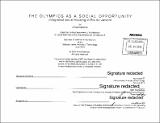The Olympics as a social opportunity : Integrated social housing in Rio de Janeiro
Author(s)
Kaertner, Anna (Anna M.)
DownloadFull printable version (13.76Mb)
Other Contributors
Massachusetts Institute of Technology. Department of Architecture.
Advisor
Miho Mazereeuw.
Terms of use
Metadata
Show full item recordAbstract
The next Olympic games will be hosted in Rio de Janeiro in the summer of 2016. While the Olympic committee advertises the event as the "games for everyone", the plans are clearly promoting development and programs that are disproportionately aimed at the wealthy. This has been the course in all cities that have hosted the Olympics, but it is something especially detrimental in Rio. The rich have largely walled themselves of from the city within their gated communities and the low income citizens are relegated to building on top of each other. This creates a spatial paradigm with relatively little in between. The thesis seeks to use the Olympics as an opportunity to begin reversing the spatial segregation between the wealthy and the poor within the city by proposing an intervention in the Olympic Village, currently designed to become a gated community, to become a mixed income community. The thesis provides an architectural plug-in that activates the ground plane between the residential towers to promote interaction between different socio-economic groups. The programs and architectural landscape of the community present obstacles and opportunities that provoke interaction. This architectural plug-in can become a model that can be applied to other gated communities, starting a process of the disintegration of the gated community to become re-integrated into the city.
Description
Thesis: S.B., Massachusetts Institute of Technology, Department of Architecture, 2015. Cataloged from PDF version of thesis. Includes bibliographical references (pages 65-66).
Date issued
2015Department
Massachusetts Institute of Technology. Department of ArchitecturePublisher
Massachusetts Institute of Technology
Keywords
Architecture.